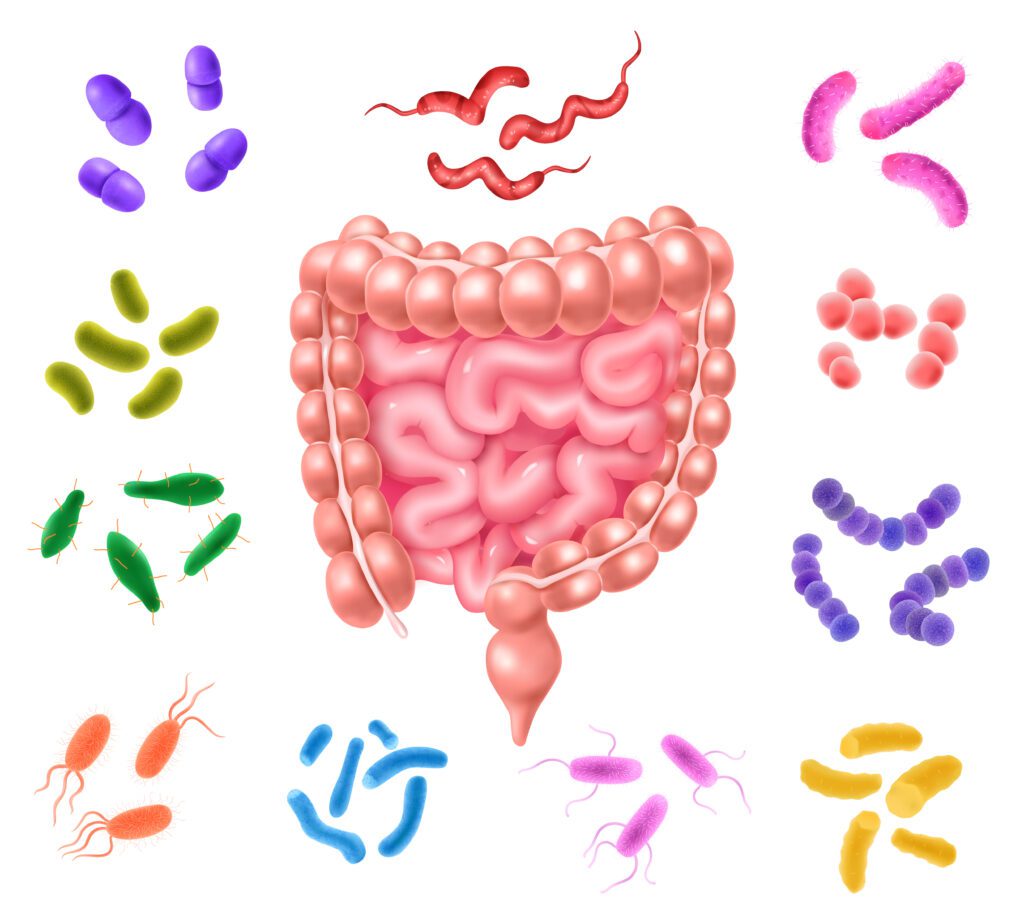If there’s one topic that has caught the attention of scientists, doctors, wellness coaches, and even food companies in the last few years, it’s the gut microbiome.

This incredible ecosystem — made up of trillions of bacteria, fungi, and other microbes — is not just sitting quietly in your gut. It’s actively influencing how you digest food, absorb nutrients, regulate hormones, manage immunity, and even how you feel emotionally.
I have been saying this for years — gut health is the cornerstone of overall wellness. When the gut is in balance, your energy improves, your skin glows, your immunity strengthens, and even your mood stabilizes.
This is precisely why microbiome testing has become one of the most popular trends in functional medicine and integrative health today. People are tired of guessing what’s wrong with their gut. They want clarity.
- And modern stool DNA/RNA tests are designed to do just that — they map the relative abundance of microbes in your gut, look at diversity scores (a key marker of resilience), flag potential pathogens or overgrowths, and even estimate your ability to produce short-chain fatty acids (SCFAs), which are critical for gut lining health and immunity.
This is why working with an expert to interpret your report is crucial.
Here’s what we’ll decode together:
- Gut microbiome: What it really is and why it’s key to your health.
- How to improve gut microbiome: Practical, evidence-based steps to build a thriving gut.
- Nutrition for microbiome: Foods that support diversity, SCFA production, and gut resilience.
- Microbiome and skin: How your gut health shows up on your skin (acne, eczema, psoriasis).
- Microbiome and mental health: The gut-brain connection and its impact on mood, focus, and emotional well-being.
We’ll also explore fascinating insights from Dr. William Li, a renowned physician-scientist and author of Eat to Beat Disease, who has conducted groundbreaking research on the impact of food on the microbiome and its natural ability to fight disease.
Gut Microbiome Testing – What Scientists and Experts Say It Can (and Can’t) Tell You
When scientists talk about gut microbiome testing today, it’s nothing short of a scientific revolution. Thanks to massive leaps in genomic sequencing and advanced computational tools, we can now peek into the hidden world of trillions of microbes living inside us.
And here’s a mind-blowing fact:
- Each teaspoon of your stool contains so much bacterial DNA that it would take 100,000 of today’s largest USB thumb drives to store all that information.
Yes, you read that right! If you tried to store all that data, it would weigh as much as a young giraffe!
So, let’s understand what these tests are actually measuring, what useful insights emerge, and what caveats remain.
What These Tests Are (Technical & Methodological Aspects)
To understand what the tests can and can’t reveal, it helps to know how they work.
- Sample type: Most microbiome analyses use stool samples. Stool is relatively easy to collect, noninvasive, and reflects many microbial populations of the colon. But stool does not fully reflect microbes adhered to the gut mucosa or small intestine contents.
- Sequencing/analysis methods:
- 16S rRNA gene sequencing identifies bacterial taxa (genus or species-level), often used because of lower cost.
- Shotgun metagenomic sequencing gives a broader picture: Bacterial + viral + fungal genes, potential metabolic capacity (which genes are present, what metabolic pathways).
- Other ‘omics’ (metabolomics, metatranscriptomics) are used in research to see what microbes do, not just who is there.

- Data outputs often include measures like:
- Alpha diversity (diversity within one sample)
- Beta diversity (differences between samples or over time)
- Relative abundance of taxa (which bacteria/fungi are more or less abundant)
- Presence/absence of specific taxa (pathogens, overgrowths)
- Potential for certain metabolic functions (e.g., SCFA production genes) in shotgun data.
- Pre-analytical conditions (before sequencing) matter a lot: How the sample is collected, stored, transported, how fast it is frozen, and the DNA extraction methods. These affect the results.
What Gut Microbiome Testing Can Tell Scientists
From multiple studies, here are insights that are reasonably well supported.
Diversity & Dysbiosis Patterns
- Healthy individuals tend to have higher microbial diversity (richness & evenness). Lower diversity is associated with metabolic disorders, obesity, inflammatory bowel disease (IBD), etc.
- Dysbiosis – an imbalance in taxa (for example, fewer beneficial bacteria, more potentially harmful ones) is common in disease states. Tests can pick up those relative shifts.
Metabolic Function Potential
- Genes linked to SCFA production (butyrate, acetate, propionate) often correlate with better gut-barrier integrity, and lower inflammation. When tests include metagenomics, these potentials can be inferred.
- Antibiotic exposure or low fiber meals often show reduced SCFA potential.
Impact of Nutrition, Medication, and Lifestyle
- Nutritional changes (e.g., increased fibers, prebiotics) can shift microbial composition in 1–2 weeks.
- Antibiotic use tends to reduce the abundance of many taxa, reduce diversity; sometimes recovery is partial or slow.
Presence of Pathogens/Overgrowths
- Tests can pick up certain microbes (bacteria, archaea, fungi, parasites) that are known to be associated with pathology, or potential overgrowths.
Baseline & Longitudinal Tracking
- Testing at multiple time points (longitudinal studies) helps map how the gut microbiome responds to interventions.
What Gut Microbiome Testing Cannot Tell
Despite many promising findings, the scientific literature points to several important limitations & cautions.
No Universal Reference ‘Healthy Microbiome’
- Because of large inter-individual variability, there is no standard ‘perfect’ microbiome profile. For example, the dominance of certain phyla (Bacteroidetes, Firmicutes) may vary greatly among healthy people.
Snapshot vs Dynamic Ecosystem
- Tests reflect one point in time; many factors (recent meals, circadian rhythms, stress, medication, stool consistency) cause day-by-day variation.
- Stool consistency itself is correlated with diversity and community composition; looser stool or different transit times alter the microbial populations seen in stool.
Incomplete Representation
- Stool mainly samples microbes in the lumen of the colon. It misses mucosa-associated microbes, microbes in the small intestine, or niches close to the gut lining or in deeper layers.

Technical/Lab Method Variability
- Differences in DNA extraction, storage temperature, sequencing method, primers used for 16S rRNA gene, and bioinformatics pipelines – all can lead to variable results.
Interpretation Challenges
- Relative abundance (proportion) does not equal activity.
- A microbe may be present in DNA, but may be dormant, or its metabolic activity may be low. Detecting DNA doesn’t confirm viability or functional contribution.
Summary: What Scientists Conclude
Putting it all together, the research suggests:
- Gut microbiome testing offers rich insights into microbial diversity, community structure, metabolic potential, and how nutrition/antibiotics/lifestyle influence those.
- But it is not yet a fully mature clinical diagnostic tool for many conditions.
My Advice: Never look at a gut test in isolation. Context matters.
- Pair the results with symptoms, meal journals, and clinical markers like inflammation, Vitamin D levels, and thyroid health.
- Avoid panic if you see scary names like ‘pathogen detected.’ Your practitioner will assess whether it’s clinically relevant.
- Lifestyle first. Focus on gut-healing nutrition, stress management, and sleep hygiene before considering supplements.
- Re-test only after 8–12 weeks of consistent lifestyle changes. That’s how you know what truly works for your body.
Remember, testing is a tool — not a diagnosis or a shortcut. It empowers you to take charge of your health, but the real healing happens through consistent, daily habits.
Insights from Dr. William Li – A Deep Dive into Gut Microbiome Testing
In my podcast with Dr. William Li, we spoke about something that’s been on a lot of people’s minds: gut microbiome testing.
Like many of you, I’ve seen these reports that look like phone books — listing hundreds of bacteria you ‘have,’ ‘don’t have,’ or ‘have too much of.’ They often end with a suggestion to take a probiotic or avoid certain foods.
And while that sounds exciting, Dr. Li reminded us that we’re still at the very beginning of understanding the gut microbiome.
Here are the three key takeaways from that conversation:
1. Diversity Matters Most
Think of your microbiome as a city. The more variety you have — chefs, engineers, plumbers, artists — the stronger and healthier the city is.
- Similarly, in the gut, high diversity equals resilience, while low diversity signals vulnerability.
- If your microbiome lacks diversity, nutrition becomes your most powerful lever.
- Eating more plant-based foods, polyphenols, and fiber is one of the best ways to improve the gut microbiome naturally.
2. Watch for the ‘Bad Guys’
Tests can sometimes reveal harmful bacteria. But here’s the important part: this is not consumer-level data to act on alone.
- If pathogenic strains show up, they need professional interpretation — often by integrative medicine specialists or gastroenterologists.
- Treating this without guidance can do more harm than good, because antibiotics don’t just kill the ‘bad guys,’ they wipe out the good ones too.
3. Don’t Forget the ‘Good Guys’
Beneficial microbes like Akkermansia, Lactobacillus, and Bifidobacteria are essential players in gut health. Missing them doesn’t mean panic — it’s a cue to focus on nutrition.
- Fermented foods, probiotic-rich foods, and polyphenol-rich plants can help restore balance. This is where nutrition for microbiomes becomes practical, not theoretical.
Dr. Li’s Final Advice – Don’t Go Into the Jungle Alone
As Dr. Li emphasized, we’re still in the ‘baby steps’ phase of this research.
- Scientists estimate we know less than 1% of the entire story of the human microbiome.
- Reports today are fascinating, but not standardized — different labs may yield different results, and the technology is still evolving.
That’s why he compared microbiome testing to venturing into a jungle: it’s exciting, full of possibilities, but you need a guide who knows the terrain. Without one, it’s easy to get lost or anxious about things that may not even matter clinically.
The Organ–Gut Axis: Your Gut Is the Body’s Control Room
After my conversation with Dr. William Li, one thing became even clearer — the gut microbiome is not just about digestion, it is at the center of nearly every process in the body. If we think of the gut as the ‘control room’ of your health, then every organ system — your brain, heart, skin, liver, bones, and kidneys — is connected to it through what science calls gut-organ axes.
Gut–Brain Axis
Ever wondered why stress upsets your stomach or why your mood shifts when your digestion is off? The gut–brain axis explains this.
- The gut microbiome produces serotonin, dopamine, and GABA — neurotransmitters that regulate mood and anxiety.
- Low microbial diversity has been linked to depression, anxiety, and even neurodegenerative diseases like Parkinson’s.
My advice: If you want better focus and emotional balance, start by working on your gut — eat a variety of plant foods, manage stress with pranayama or meditation, and avoid unnecessary antibiotics that disrupt the microbiome. This is one of my top recommendations on microbiome and mental health.
Gut–Skin Axis
I often remind my clients that glowing skin is not just about creams and serums; it starts in the gut.
- Dysbiosis (imbalance in gut microbes) can worsen acne, eczema, psoriasis, and even trigger hair loss (alopecia areata).
- SCFAs produced by healthy gut bacteria strengthen the skin barrier and calm inflammation.
We recently worked with Manu, who struggled with persistent acne despite trying multiple creams and treatments. Once her gut health was addressed — through simple dietary and lifestyle changes — her skin started healing from within.
Read her full story here:
My advice: If you’re struggling with skin issues, focus on nutrition for microbiome — add fermented foods, prebiotics (garlic, onions, asparagus), and stay hydrated.
Gut–Liver Axis
The liver receives nearly 70% of its blood supply from the gut, which means everything from your microbiome passes through it.
- An unhealthy gut can overload the liver with inflammatory compounds, contributing to fatty liver disease or poor detoxification.
My advice: Keep your gut lining healthy — eat fiber, reduce alcohol, and manage stress — so that your liver isn’t overwhelmed.
Gut–Heart Axis
A leaky gut and dysbiosis can raise inflammatory molecules like trimethylamine n-oxide (TMAO), which are linked to heart disease and stroke risk.
- People with heart failure often have poor gut blood flow, which worsens nutrient absorption and overall health.
My advice: Support your gut diversity with polyphenol-rich foods like berries, olive oil, and green tea — they feed beneficial bacteria and lower inflammation naturally.
Gut–Bone Axis
Few people know this, but your gut bacteria help absorb minerals like calcium and magnesium, which are crucial for strong bones. Similarly, kidney health is influenced by microbial toxins — dysbiosis can speed up kidney damage.
My advice: Balance your meals with the right carb-to-protein ratio, and include probiotics like Lactobacillus reuteri and Bifidobacterium longum, which have been linked to higher bone density.
Lifestyle Foundations – How to Improve Your Gut Microbiome
Although gut microbiome testing is evolving rapidly and will one day be a mainstream clinical tool, the foundations of good gut health remain the same — your daily food and lifestyle choices.
As I often share in my blogs and videos, you don’t have to wait for a fancy test to start healing your gut. Small, consistent actions work like powerful medicine.

Nutrition Basics
Your gut thrives on diversity. Eating 25–30 different plant-based foods every week is one of the simplest ways to improve microbiome diversity and boost beneficial bacteria.
Here’s what I recommend focusing on:
- Prebiotic-rich foods: Feed the good bacteria so they can flourish. Garlic, onions, oats, asparagus, bananas, legumes, and flaxseeds. These are like ‘fertilizer’ for your microbiome.
- Fermented foods: Naturally add live cultures and enzymes. Curd, kefir, homemade pickles, and dosa/idli batter. Start small — too much too soon may cause bloating initially.
- Polyphenol power: Compounds in plant foods that reduce inflammation and feed beneficial microbes. Berries, green tea, cocoa, colorful vegetables, and olive oil. Polyphenols increase Bifidobacteria and Lactobacilli populations.
Prebiotics, Probiotics & Synbiotics – Simplified
This is where most people get confused — which supplement to choose, how long to take it, and whether it even works. Here’s a simple guide (we have a detailed blog on this — do check it here, if you want to go deeper):
| Type | What It Is | Why It Matters | Pro Tip |
| Probiotics | Live beneficial bacteria. | Help rebalance gut flora, improve digestion, immunity, and even mental health. | Start with food first: curd, kefir, kimchi, homemade pickles. If you still need extra support (e.g., post-antibiotics), choose strain-specific probiotic supplements for 4–8 weeks and track your symptoms (under expert guidance). Try our 4-ingredient probiotic drink. |
| Prebiotics | Non-digestible fibers that feed good bacteria. | Nourish your gut’s beneficial microbes, helping them multiply and produce short-chain fatty acids (SCFAs). | Focus on a variety of plants: garlic, onions, oats, asparagus, legumes. Supplements should be a second step, if your diet cannot meet needs. |
| Postbiotics | Byproducts made by bacteria (like SCFAs, peptides). | Support immune health, lower gut inflammation, and strengthen the intestinal barrier. | You don’t need a pill for this — just eat enough fiber, polyphenols, and fermented foods to help your gut microbes make these naturally. |
| Synbiotics | A combination of probiotics + prebiotics. | Improve survival of probiotics in the gut and enhance benefits. | Best done through food pairings: e.g., yogurt with fruit, dosa with sambar (fermented + fiber). If supplementing, pick clinically studied synbiotics, not random blends. |
Avoid random supplements promoted online — many have poor quality control. Always work with a qualified expert before supplementing.
Beyond Food – Lifestyle for Gut Health
Your gut doesn’t just respond to what you eat — it listens to how you live.
- Prioritize sleep: Aim for 7–8 hours daily of quality rest. Poor sleep alters gut microbiota composition within 48 hours.
- Move daily: Walks, yoga, and strength training improve microbiome diversity and reduce systemic inflammation.
- Get nature exposure: Contact with soil microbes and natural environments has been shown to enrich gut diversity.
- Manage stress: Chronic stress alters gut permeability (‘leaky gut’) and increases dysbiosis risk. Simple practices like breathwork, meditation, or journaling can bring the gut–brain axis back into balance.
- Use antibiotics wisely: When necessary, use them — but rebuild gut diversity afterward with food diversity and probiotics.
- Respect your gut clock: Your gut loves routine — respect its circadian rhythm. Eat meals at roughly the same times daily, chew food thoroughly, and practice mindful eating to support digestion.
The Last Word
Gut microbiome testing is an incredible scientific tool — we’ve come a long way with genomic sequencing and computational analysis. But remember, even the most advanced test is only a snapshot of what’s happening today.
This is why I always encourage people to treat microbiome test results as a guide, not a verdict. They can reveal patterns — dysbiosis, low diversity, lack of fiber fermentation — but they cannot predict your health destiny. What you do with that information matters more than the report itself.
And that’s where bio-individuality comes in. What works for one gut may not work for another. The goal is not to chase a ‘perfect microbiome,’ but to make consistent, science-backed lifestyle choices that nurture balance over time.
And always remember — be informed, don’t get influenced.
Frequently Asked Questions
What is the gut microbiome?
The gut microbiome refers to trillions of microbes in your digestive tract that influence digestion, immunity, hormones, and mental well-being. A healthy gut microbiome supports nutrient absorption, immune balance, and even skin and brain function, forming the foundation for overall wellness.
What is gut microbiome testing?
Gut microbiome testing analyzes stool or biopsy samples to estimate microbial diversity, abundance, potential pathogens, and metabolic capacity. While it provides insights into gut health trends, it doesn’t diagnose disease. Results are best interpreted by trained specialists alongside diet, lifestyle, and lab markers for actionable guidance.
How can I improve my gut microbiome?
How to improve gut microbiome includes eating 25–30 different plant foods weekly, prebiotics like garlic and oats, and fermented foods such as yogurt or kefir. Consistent sleep, stress management, and physical activity also support microbial diversity, resilience, and overall gut health.
Which foods are best for nutrition for the microbiome?
Nutrition for microbiome emphasizes prebiotic fibers, fermented foods, and polyphenol-rich items like berries, tea, and cocoa. These foods feed beneficial microbes, reduce inflammation, and enhance gut balance, indirectly supporting skin, mental health, and immunity. Mindful and consistent intake maximizes benefits.
Can gut microbiome testing affect skin or mental health insights?
Microbiome and skin, and microbiome and mental health are influenced by gut microbial diversity. Testing may highlight imbalances linked to acne, eczema, or mood disorders. While tests provide trends, actionable strategies include dietary changes, fermented foods, and stress management, not relying solely on test results.
Disclaimer: The information provided here is for educational and informational purposes only. It is not intended as a substitute for professional medical advice, diagnosis, or treatment. Always consult your healthcare provider before making changes to your nutrition, lifestyle, or healthcare regimen, especially if you have existing medical conditions or are taking prescribed medications.
Want personalized guidance on gut health issues?
We help you find a way.
Set up a one-on-one consultation with our integrative team or explore our Wellness Programs to optimize your lifestyle goals.
Reach out to us at 1800 102 0253 or write to us at consults@lukecoutinho.com.

Team Luke
Start Your Wellness Journey
Feeling inspired to take the next step in your wellness journey? Connect with us to explore how our tailored programs can support your health journey. Your transformation is just a conversation away.



